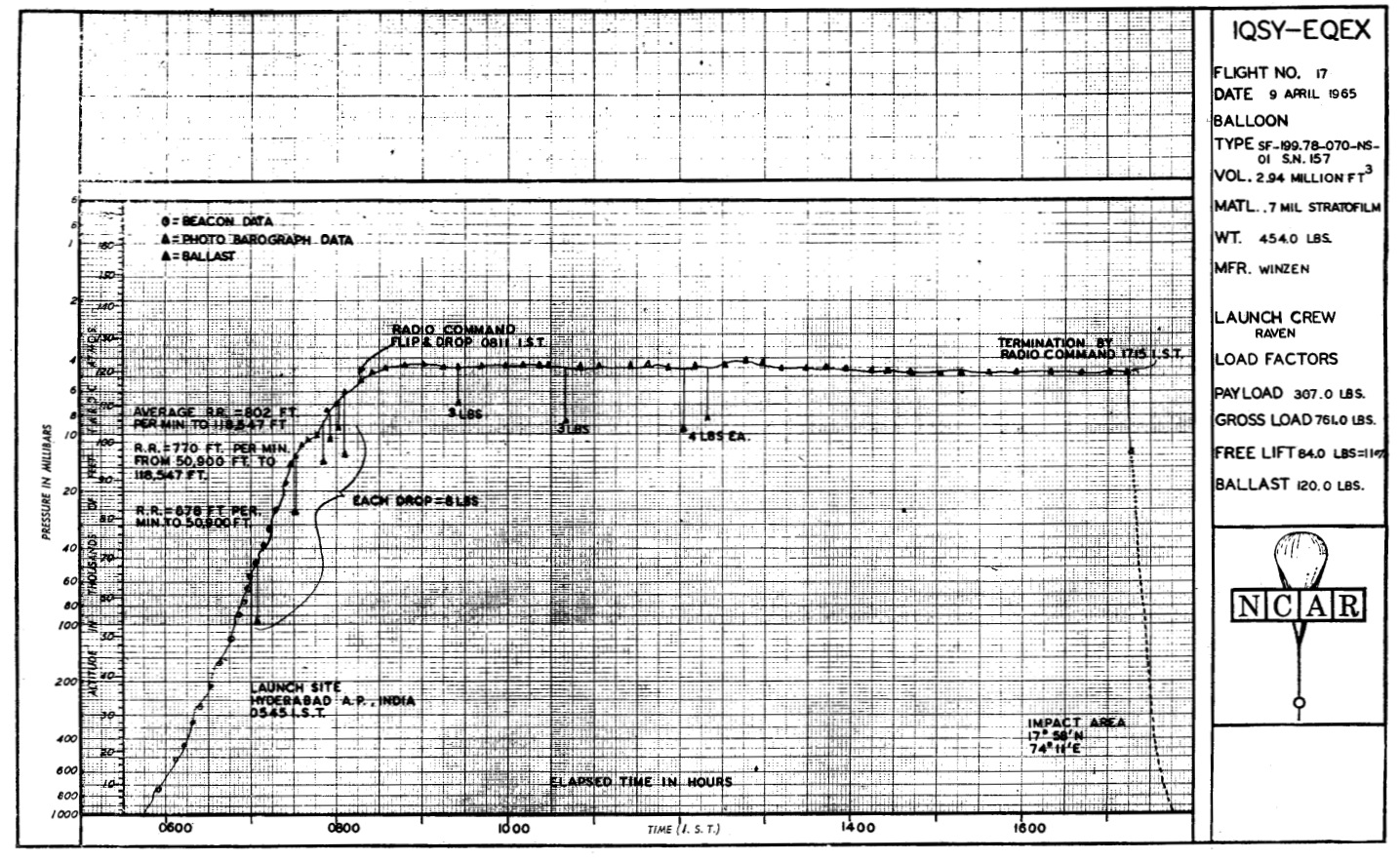Purpose of the flight and payload description
This flight was part of a balloon expedition to study cosmic rays in the vicinity of the equator during the International Quiet Sun Year (IQSY) organized and managed by the National Center for Atmospheric Research as a joint United States - India activity. The program was conducted in Hyderabad, India during the late winter and early spring of 1965.
The main objective of the flight was to expose a package of nuclear research emulsions with various sensitivities and having a large horizontal area provided by the U.S. Naval Research Laboratory, Washington, DC. The mission called for the detector to reach reach a pressure altitude of approximately 3 mb and stay there for 10 to 12 hr. That would make possible for the first time to obtain a charge spectrum for primary heavy nuclei with an almost negligible correction for fragmentation in the overlying atmosphere near the earth's magnetic equator. These data, in combination with data obtained from similar exposures during IQSY at Ft. Churchill and Minnesota, would make possible the comparison of spectra, fluxes and ratios of light to medium to heavy groupings for primary cosmic ray nuclei with Z > 3 over a wide range of energies. The combined data could then be used to study various mechanisms which may play a role in the propagation of the cosmic radiation through interstellar space.
Another experiment was provided by the University of Tasmania and consisted of a flight unit containing a 3-fold Geiger counter telescope and two BF3 counters. Both BF3 counters were enclosed in polyethylene moderators 1 in. thick. One counter contained BF3 enriched to 96% in the isotope B10 while the other contained the natural isotopic mixture of boron. The latter was referred to as the unenriched counter. This flight unit was similar to units previously flown at latitudes between Wilkes, Antarctica, and Lae, New Guinea for the purpose of studying the latitude effect on cosmic ray neutrons during the period of minimum solar activity. By making the measurements at Hyderabad it was possible to extend this survey to a geomagnetic cut-off of 17 BV compared with 15.8 BV at Lae. Data from the survey have permitted information on the flux of albedo neutrons and on the rate of production of C14 in the atmosphere to be obtained.
As this was the last scheduled launch of the program, and since several smaller scientific experiments had not been flown, this flight included also several detectors and emulsion packages provided by Tata Institute of Fundamental Research, Bombay, and Osmania University, Hyderabad, India.
Details of the balloon flight

Balloon launched on: 4/9/1965 at 5:45 ist
Launch site: Osmania University Campus, Hyderabad, India
Balloon launched by: Raven Industries Inc.
Balloon manufacturer/size/composition: Zero Pressure Balloon Winzen 2.940.000 cuft (0.7 Mil. Stratofilm)
Balloon serial number: SF-199.78-070-NS-01 S/N 157
End of flight (L for landing time, W for last contact, otherwise termination time): 4/9/1965 at 17:15 ist
Balloon flight duration (F: time at float only, otherwise total flight time in d:days / h:hours or m:minutes - ):
Landing site: Payload impact at coordinates: 17º 58' N, 74º 11' E
Campaign: No Data IQSY-EQEX
Payload weight: 307 lbs
Overall weight: 761 lbs
The balloon was launched at 5:45 local time and reached ceiling of 118,500 ft at 8:11. After 9.25 hr at ceiling, the flight was terminated, with impact occuring at 170 58' N, 740 11' E. The payload was successfully recovered.
External references
- Ballooning Support for Cosmic-Ray Experiments NCAR Technical Note NCAR/TN-20, September 1966
15886If you consider this website interesting or useful, you can help me to keep it up and running with a small donation to cover the operational costs. Just the equivalent of the price of a cup of coffee helps a lot.

